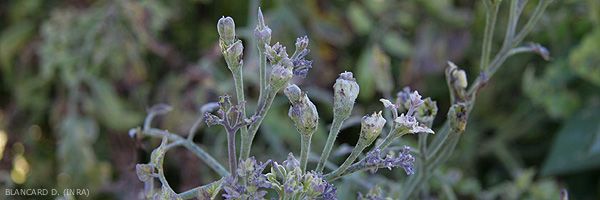
" Candidatus Phytoplasma solani"...
yellows of the queen-daisy ...
- classification: Bacteria, Firmicutes, Mollicutes, Acholeplasmatales, Acholeplasmatacae
- English names: stolbur, aster yellows, tomato big bud ...
From year to year, the incidence of phytoplasmosis on tomato crops can be very contrasting. In many situations, a few diseased plants can be observed, scattered throughout the crop, expressing characteristic symptoms. Their low frequency is never in this case worrying; plants are often seen as mere curiosities. But they can also cause considerable damage in tomato crops: the proportion of affected plants can then be very high, reaching 30 to 40%, or even, in particularly serious situations, almost all the plants. In addition, if the infections took place early, the yields are very low, or even zero, because of the sterility of many bunches, and the small size of the few fruits produced.
The stolbur is widely distributed throughout Europe . In France , it is not uncommon to observe it in the open field , exceptionally under shelters on plants near the openings. Serious epidemics have been observed occasionally over time, particularly in 2006.
Several phytoplasma diseases , associated with fairly comparable symptoms on tomatoes, have been described in many production areas around the world and under different names: “stolbur”, “big bud”, “yellows”, “proliferation” For several decades, the difficulties encountered in studying the phytoplasmas in question and the lack of efficient methods to characterize them prevented us from knowing with precision whether we were dealing in all cases with the same microorganisms. The advent of molecular tools has facilitated the classification of phytoplasmas into several groups and subgroups, in particular according to the analysis of the sequence of their ribosomal 16S RNA. Thus, several phytoplasmas have been described on tomato in several countries: Candidatus Phytoplasma asteris, C. Phytoplasma aurantifolia, C. Phytoplasma pruni, C. Phytoplasma ulmi, C. Phytoplasma trifolii, C. Phytoplasma solani, C. Phytoplasma australiense.
Many vegetable crops are affected by phytoplasmas belonging especially to the group yellows of the daisy queen (Aster yellows), phytoplasmas widely distributed throughout the world. Note that on tomato, several phytoplasmas members of different groups can occur in the same country, rarely on the same plant, as is the case for example in Italy.
Finally, note that several strains of phytoplasmas responsible for a stolbur or not have been described under various names: "parastolbur" (stolbur), "metastolbur" (stolbur), "northern stolbur" (probably Potato witches' broom), " pseudoclassic stolbur ”(ill-defined) and“ pseudostolbur ”(a physiological disease). In addition, a so-called “small leaf” phytoplasma disease, different from stolbur, was reported in France during the 1980s.





